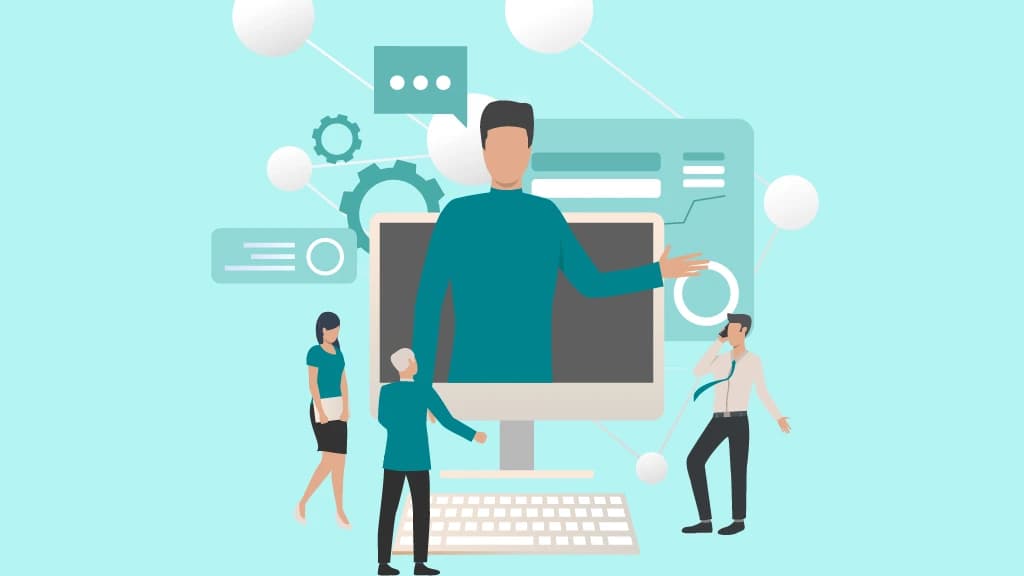
HR automation aims to make the workplace smarter and more engaging, along with saving manual labour or streamlining paperwork. AI integration is redefining HR processes and changing the way we interact with and inspire our employees. And leading the way in this change? An innovative technology for HR automation is agentic AI.
From personalized employee experiences to predictive workforce analytics, agentic AI is revolutionizing HR teams’ operations and increasing the impact, adaptability, and intuitiveness of HR process automation. Let’s look at 5 HR automation trends driven by AI Engagement and examples that describe our future workplace.
Agentic AI in Engagement
Do you want to know how to automate the human resources process? AI in engagement platforms is revolutionizing human resources by creating meaningful and enduring employee experiences that go beyond productivity. In addition to automating tasks, these platforms seek to foster a connected and inspired work environment where employees feel valued and active.
What is Agentic AI?
Agentic AI, an active participant in engagement activities, is an example of a proactive approach to artificial intelligence. Agentic AI starts conversations, makes proactive recommendations, and instantly adjusts to the needs of employees, in contrast to passive systems that only react to inputs. For example, an AI can identify when a worker is doing exceptionally well and encourage a manager to acknowledge them or recommend wellness resources that are specific to each worker’s engagement habits. HR can create a more encouraging and dynamic work environment by moving from reactive to proactive engagement.
Benefits of Agentic AI:
-
Beyond Transactional Processes
Payroll and compliance are two crucial yet transactional tasks that are the focus of traditional HR. Agentic AI goes one step further by integrating gratitude and acknowledgment into routine tasks. Instead of waiting for an annual review, AI can prompt real-time employee feedback and reward systems, making appreciation an everyday experience. -
Creating Meaningful Interactions
No two employees are the same, and engagement should reflect that. Agentic AI is excellent at evaluating data to comprehend the motives, preferences, and behaviors of employees. This results in individualized experiences that improve pleasure and engagement, increasing the significance and effect of interactions. -
Driving Business Success
Engaged employees aren’t just happier—they’re also more productive, innovative, and loyal. HR directors can better align engagement activities with business objectives and achieve quantifiable outcomes by using data-driven insights from agentic AI. This AI-driven strategy ensures that HR activities result in quantifiable results, whether it is by enhancing team cooperation, recognizing trends in turnover risks, or optimizing rewards programs.
With a reactive approach to a proactive, engagement-first strategy, Agentic AI is making HR automation more human-centric. It’s not just about efficiency—it’s about building a thriving workplace where employees and businesses grow together.
Trends in Automation of HR processes
1. From Task Automation to Culture Transformation
HR automation tools were initially prioritized for efficiency, decreasing errors, eliminating manual processes, and saving HR personnel numerous hours. Even while these developments were crucial, they just touched the tip of the iceberg. Automation is now actively influencing corporate culture rather than just streamlining processes.
Embedding Recognition and Appreciation
Appreciation is the foundation of a flourishing company culture. However in the rush of daily tasks, recognition frequently gets missed. AI can automate recognition programs, guaranteeing that employees receive appropriate and significant credit for their accomplishments. Sending thank-you notes or employee appreciation quotes is as vital as fostering a culture where thankfulness is a daily occurrence. Digital and automatic employee recognition awards and recognition systems such as Advantage Recognition provide real-time appreciation and foster a recognized culture.
Promoting Inclusivity and Belonging
AI can also promote inclusiveness by uniting like-minded employees and enabling the formation of Employee Resource Groups (ERGs). By studying employee preferences and behaviors, these automated engagement solutions help in building professional and social networks. These workplace communities, such as Advantage Communities, let people connect and create a feeling of community inside the company.
2. Intelligent Recognition & Rewards: AI-Powered Motivation at Scale
Employee appreciation is a business requirement, not simply a nice-to-have. When people feel appreciated, they perform better. The difficulty? Conventional recognition techniques frequently lack timeliness and personalization. Automation of HR processes is filling that gap, increasing the efficacy, significance, and scalability of incentives and recognition.
Personalized Recognition
Nowadays, automated systems analyze performance statistics to customize gratitude according to each person’s efforts. Automated recognition makes sure workers feel seen and valued, whether it’s for a significant project milestone or for recognizing continuous effort.
Automated Reward Distribution
Recognition should be easy to give—and just as easy to receive. Automated reward systems take the guesswork out of the process by offering curated rewards that match employee preferences. Employees can select incentives that truly speak to them, such as gift cards or branded goods. Employers can make sure that workers feel appreciated in the ways that are most important to them by utilizing data-driven insights to improve their recognition efforts.
3. HR Automation Tools That Strengthen Employee Sentiment
A successful workplace is about how people feel on a daily basis, not only about the rules and benefits. Are they engaged? Inspired? Angry? Building a workplace where individuals feel acknowledged and appreciated requires an understanding of employee sentiment. The good news? HR automation tools have made it easier than ever to take meaningful action and record findings in real time.
Real-Time Pulse Surveys
Although annual surveys are useful, they frequently fall short in capturing the experiences of employees on a daily basis. Pulse surveys can help with that. Short, frequent check-ins—delivered through surveys, polls, quizzes, and mood assessments—help HR leaders get a real-time sense of employee morale. These quick snapshots provide deep insights, allowing organizations to make informed decisions before small frustrations turn into bigger issues.
Sentiment Analysis
Employees share valuable feedback all the time—through surveys, chat messages, emails, and even social media. The challenge is making sense of it all. Sentiment analysis helps HR teams detect trends and spot early warning signs of disengagement or dissatisfaction. Whether it’s identifying concerns about workload, communication gaps, or leadership issues, these insights help HR act proactively, ensuring employees feel heard and supported.
4. Gamification & Behavioral Analytics: The New Age of HR Automation
Gamification and behavioral analytics inject energy and engagement into everyday tasks. From sales incentives to wellness challenges, these tools make work more interactive, motivating employees in ways that feel both fun and rewarding.
Incorporating Gamification
Gamification has transformed how companies drive motivation. Organizations can increase interest and encourage participation in HR initiatives by incorporating game-like aspects. For example, gamified sales contests and performance-based incentives in Advantage Incentive Automation keep employees motivated by offering rewards for hitting key milestones. From step-count competitions to mindfulness streaks, wellness programs with gamified features on Advantage Wellness encourage healthy habits and friendly competition.
Behavioral Analytics
Behavioural analytics can find out the reason why employees participate in some initiatives but not others. HR can modify engagement tactics to accommodate various work styles and preferences by examining how employees connect with company activities. Predicting burnout risk or identifying what incentives drive performance, these insights help organizations create employee rewards programs that genuinely resonate with employees.
5. AI-Powered HR Automation Examples that Go Beyond Efficiency
In addition to speeding up procedures, the HR automation tool seeks to make processes more intelligent, intuitive, and, most importantly, human. Here are some examples of how AI is transforming HR procedures:
Automated Peer-to-Peer Recognition
Automated peer-to-peer recognition makes it simple for colleagues to acknowledge one another’s contributions in real time. Whether through an internal platform, chat integration, or a digital rewards system, these seamless prompts help reinforce a culture of appreciation without adding extra effort.
Real-Time Engagement Insights
Outdated annual surveys are no longer necessary as real-time engagement insights provide HR with the most up-to-date data on employee satisfaction. Advantage Pulse‘s well-designed pulse surveys and sentiment analysis tools give a clear picture of what is working and what is not. The insights enable managers to take preventative action before small issues turn into bigger retention issues.
Dynamic Reward Structures
What excites employees six months from now might not be what inspires them today. A one-size-fits-all rewards program frequently fails because of this. AI-driven incentive programs adjust to changing employee preferences and workforce trends to keep recognition current. Offering experiences rather than cash bonuses, implementing unexpected incentives, or customizing awards for various teams are just a few examples of this innovative method that keeps recognition fresh and inspires workers in ways that really speak to them.
HR will be more intelligent, connected, and efficient in the future because of simplified recognition, engagement tracking, and rewards.
The Future of HR Automation is Engagement-First
HR technology is moving beyond traditional processes as engagement-first automation gains traction. In addition to managing payroll and benefits, the technology makes real connections, provides timely recognition, and ensures that workers receive the assistance they need.
At the heart of this transformation is proactive and adaptive technology that not only responds to employee needs but also anticipates them. These technological advances promote a culture in which engagement isn’t an afterthought but rather is woven into the very fabric of everyday work life, whether that involves acknowledging accomplishments, encouraging supervisors to offer feedback, or addressing disengagement concerns before they become serious.
Automation of HR processes will give way to culture transformation as companies continue to incorporate AI-driven solutions into HR procedures. The next wave of HR innovation will be evaluated on the value it brings to teams, employees, and the company, as well as the amount of work it saves. A workplace where people feel connected, appreciated, and empowered isn’t just good for engagement—it’s the key to long-term business success.






